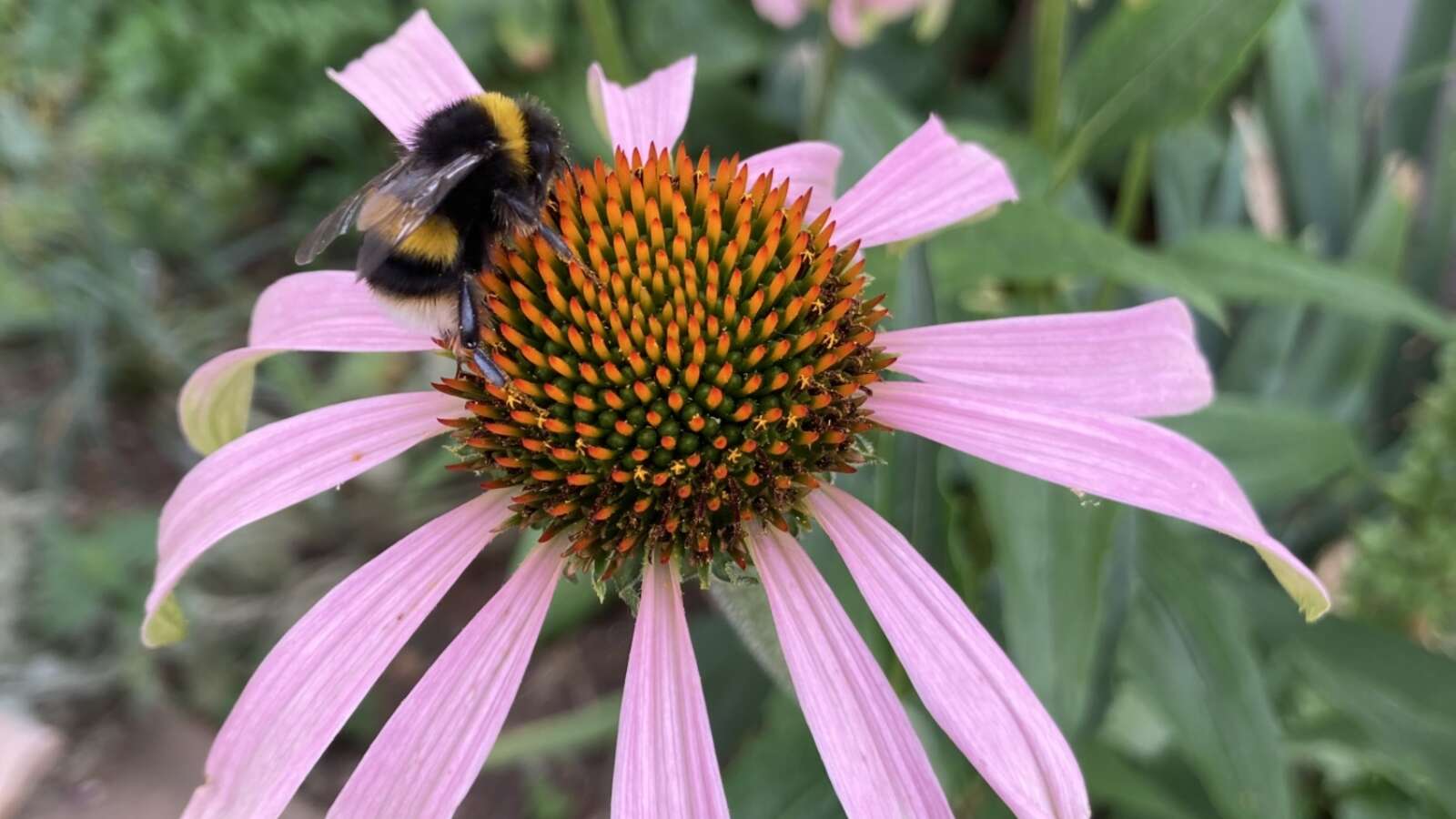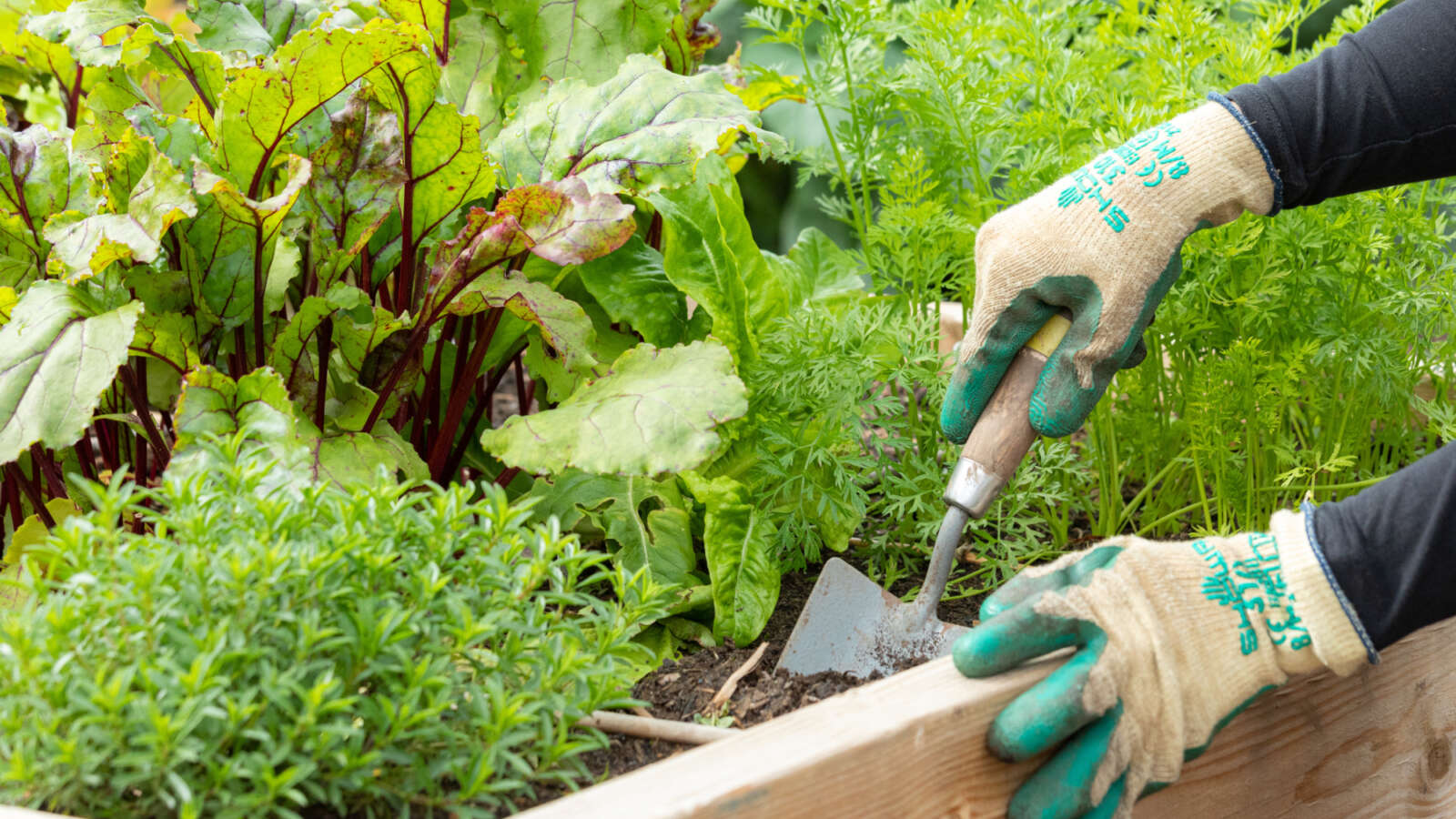
Your organic garden in July
July is the month when all the hard work pays off. Herbs and flowers are fragrant, and the soil rich with your homemade compost. After the rush of May and June growth, you can relax a little and enjoy the fruits of your labour.
See below for advice on soil, vegetables, fruit, herbs and flowers as well as the greenhouse and conservatory, lawns and ponds. Also What to Sow and Plant in July and Vegetable Growing Cards for advice.
Soil and composting 🔗
Soil
- Cover all bare soil with mulches to prevent moisture loss. For instance, grass clippings piled thickly onto layers of newspaper (6 – 8 sheets). Before applying mulches, hoe off any weeds and water dry soil well. See Managing your soil and the members' fact sheet Mulches: weed prevention and control.
Composting
- As you add material to the compost heap, mix greens (nitrogen rich) with browns (carbon rich) at a 50/50 ratio.
- Dry heaps will need watering.
- Turning the heap will aerate it and speed up decomposition. See Home Composting.
- If you have a worm bin, make sure it doesn't get too hot and kill the worms. See members' factsheet on Worm composting.
Vegetables 🔗
- If your first sowings failed, there is still time to sow lots more veg through July for late summer and autumn cropping (including French beans for a September crop).
- Before going on holiday, hoe, weed and mulch to keep weeds under control and the soil moist, while you are away.
- Sow a green manure crop if you still have large areas of bare ground. Suitable for this month are buckwheat, mustard, phacelia, crimson & red clover, fenugreek and trefoil.
Pest and disease watch
- Beware of carrot fly when thinning carrots; the scent released from the bruised foliage will attract the pests. Use a fine mesh barrier to protect plants.
- Also use a fine mesh to protect brassicas from cabbage white butterflies. Check plants for eggs and caterpillars, and squash any on sight to reduce infestations. Ditto for peas and pea moth.
- If slugs are a problem, check your traps, especially after rain. This could be a daily task. See Slug controls.
- If dealing with aphids, remember washing up liquid is not soap, it is a powerful detergent designed to de-grease a frying pan. Plants' tender new growth can be severely damaged if sprayed with a solution. It is better to squish aphids by hand (wear gloves if squeamish).
- Potato blight spores will wash down from the leaves into the soil. Protect tubers by earthing up plants, or mulching them with a thick layer of straw or leafmould. If foliage is severely affected, it is better to defoliate completely to clear away the spores.
- Other pests and diseases to look out for include asparagus beetle, onion white rot, flea beetles in brassicas, allium leaf miners in onions, leeks and shallots. See Pests and Diseases for treatments. Also members' factsheets: Flea Beetle; Potato Blight; Allium leaf miner; Leek Moth; Onion white rot; Slugs and Carrot fly.
Fruit 🔗
- July is the month that the fruit garden comes into its own. However, once a crop has been harvested, remove protective nets to allow birds back in; they will continue to pick off pests over the rest of the summer.
- Thin out apples and pears, particularly if you have a heavy crop. Firstly remove any diseased, damaged or unusually small fruits. Then carefully reduce numbers to no more than 2 or 3 per cluster. You will get larger sweeter fruits as a result.
- If you have not mulched under your strawberries with straw, do not delay. It helps to reduce grey mould (botrytis). Once fruiting has finished, cut off old leaves to prevent disease.
- Summer prune red and white currants (not blackcurrants) and gooseberries. This allows more air circulation, lets light in to ripen the fruit, and reduces disease. Trim back all side shoots to 3 or 4 buds from their point of growth and cut out crossing shoots in the middle of the bush.
Pest & Disease Watch
- Inspect fruits frequently and remove any leaves infected with botrytis (grey mould). Do not add to the compost heap.
- Raspberry rust is a common fungal disease, but rarely serious. However, it can cause early leaf drop and reduced vigour, so pick off and destroy infected leaves. Rake up and remove all fallen leaves. Consider re-planting a rust resistant cultivar, such as Glen Prosen, in a new site.
- Continue to carry out a twice-weekly search for gooseberry sawfly larvae. Start in the centre of the bush and work outwards. Pick off and destroy.
- Cut out apple twigs and leaves infected with powdery mildew.
- To protect wall or fence trained fruit, such as peaches and nectarines, drape fleece or fine mesh over the tree. Secure it to a supporting structure, ensuring no gaps.
- Hang up codling moth pheromone traps in apple trees. The sticky traps lure the male moths so disrupt their mating cycle.
Herbs 🔗
- Mulch around moisture-loving herbs, such as agastache, basil, chamomile, coriander, fennel, mint, bergamot, silver tansy and sweet mace. Use grass mowings and newspaper layers, after watering.
- Let herbs flower to encourage and feed pollinators. Many have edible flowers, such as borage, bergamot and chives. See Edible Flowers or the members' factsheet: Edible flowers.
Flowers 🔗
- Hoe and remove weeds regularly, before they have a chance to seed. For perennials with deep roots, use boiling water or a flame-weeder. Treatment must be frequent to prevent plants making growth. See Weeds and how to manage them.
- Cover bare soil where moisture can evaporate, either with mulches (compost, grass cuttings on newspaper - after watering) or with ground cover plants. See members' factsheet: Mulches: weed prevention and control.
- Keep watering plants in dry spells, especially climbers, growing at the base of a wall or fence. This always tends to be a dry spot even in heavy rain, and these plants frequently suffer from powdery mildew, induced by dryness at the roots.
- Roses can get black spot.
- Save almost-clean water from salad and vegetable washing, for use on the garden. Don’t use water that has had strong soaps, detergents or cleaning fluids added.
- Keep bird-baths topped up and clean. Birds are superb pest-predators, feeding aphids and small caterpillars to their young.
- Many flowers are delicious to eat. They make colourful additions to salads and other dishes. See Edible Flowers. Below is a list of flowers safe to eat - do not try other flowers without expert advice, some can be poisonous:
- Pot marigold (Calendula officinalis)
- Nasturtium (Tropaeolum majus)
- Heartsease (Viola tricolor)
- Dandelion (Taraxacum officinale)
- Violet (Viola odorata)
- Pinks (Dianthus sp.)
- Borage (Borago officinalis)
- Bergamot or Bee balm (Monarda didyma)
- Day lily (Hemerocallis sp.)
- Rose (Rosa sp.)
- Anise hyssop (Agastache foeniculum)
- Chives (Allium schoenoprasum)
- Garlic chives (Allium tuberosum)
Keeping the growing area healthy 🔗
- Leaf spots, rusts and rose blackspot are rarely killer diseases; they just disfigure. Remove affected leaves, flowers and berries and put in the green waste bin for professional composting.
- Avoid sprays, even organic ones, as they also target the predators such as hoverflies, ladybirds and parasitic wasps. Squash large aphid colonies with your fingers – wear gloves if squeamish.
Greenhouse
- Leave doors open on warm sunny days for good ventilation to discourage disease build-up.
- Nip off and destroy any diseased leaves on sight; botrytis (grey mould) and other pathogens will spread if given a chance.
- Don't over-water, and avoid wetting leaves when watering. Wet leaves = spore germination.
- Use biological controls (see Nematodes) to prevent pests such as red spider mite, whitefly and sciarid fly. Biological control is less effective when an infestation has been allowed to build up. Squish pests by hand (wear gloves if squeamish), until the biological controls arrive.
- In the conservatory, check for vine weevils and use a nematode for control, treating every pot. They particularly like fuschias, heucheras and succulents.
Pond
- Provide sheltering plants close to the pond so that water-loving wildlife can climb in and out without exposure.
- The pond itself needs two-thirds of its surface covered by plants of some sort to keep algae at bay. See members' factsheet: Setting up a pond.
Lawns and hedges
- Grass is a drought survivor so don't bother to water your lawn in dry spells, even if it starts to turn yellow and brown. It will recover very quickly when the rain does come. See The organic lawn.
- In hot weather, raise the mower cutting height to at least 3-4cm. Cutting it shorter weakens the grass.
- Leave the box off the mower. The clippings will rot speedily in warm weather, returning valuable nitrogen to the growing grass. Alternatively, any collected mowings can be used (over layers of newspaper) as mulches to retain moisture around plants. Always mulch onto moist soil. Or add to the compost heap, alternated with dry, carbon rich, material - such as straw, cardboard and crumpled up paper.
- Trim back hedges now, but still check for active nests. Some birds have several broods each year.
- If the hedge looks straggly and feeble, add garden compost to help stimulate growth long-term.
